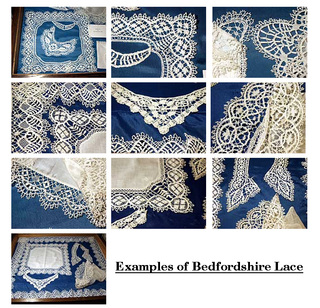
Lace was probably made in the Eastern Counties (Buckinghamshire, Bedfordshire, Northamptonshire) prior to 1563. This was, and still is, a flax growing area.
The first wave of lace makers from the continent came in 1563 to 1568. They were Flemish Protestants who left the area around Mechelen (Mechlin / Malines) when Philip II introduced the Inquisition to the Low Countries.
1567: It is estimated that 100,000 left Flanders when the Duke of Alva became head of the Spanish Catholic Army. Most of that number came to England.
In 1586 Lord William Russell, son of the Duke of Bedford, owned property near Cranfield, Bedfordshire. This is about 10 miles from Olney. He had fought for William the Silent in the Low Countries and he was married to Rachel, daughter of the Huguenot Marquis de Rivigny. He invited many refugees to settle under his protection.
Another English gentleman, who had fought for William of Orange, was George Gascoigne: he invited other Huguenots to settle near his manor at Cardington, Bedford.
Huguenot emigration continued untiI the Edict of Nantes in I598. However when the Edict was rescinded in 1685 by Louis XIV, there was another wave of religious refugees. About 10,000 left Burgundy and Normandy. The lace makers found their way to the by now well-established lace villages in the counties of Buckingham, Bedford and Northampton.
The first wave of lace makers from the continent came in 1563 to 1568. They were Flemish Protestants who left the area around Mechelen (Mechlin / Malines) when Philip II introduced the Inquisition to the Low Countries.
1567: It is estimated that 100,000 left Flanders when the Duke of Alva became head of the Spanish Catholic Army. Most of that number came to England.
In 1586 Lord William Russell, son of the Duke of Bedford, owned property near Cranfield, Bedfordshire. This is about 10 miles from Olney. He had fought for William the Silent in the Low Countries and he was married to Rachel, daughter of the Huguenot Marquis de Rivigny. He invited many refugees to settle under his protection.
Another English gentleman, who had fought for William of Orange, was George Gascoigne: he invited other Huguenots to settle near his manor at Cardington, Bedford.
Huguenot emigration continued untiI the Edict of Nantes in I598. However when the Edict was rescinded in 1685 by Louis XIV, there was another wave of religious refugees. About 10,000 left Burgundy and Normandy. The lace makers found their way to the by now well-established lace villages in the counties of Buckingham, Bedford and Northampton.